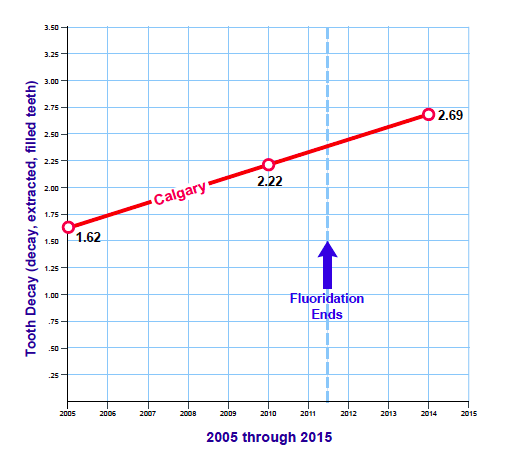The Documents:
– The Omitted Data
– Dr. Sheldon’s Statement
Calgary Fluoride Study Fatally Flawed; Key Data Omitted
A recently published study concludes that tooth decay rates in Calgary, Alberta, have increased because of the city’s decision to scrap its fluoridation program. But the study omits data showing that the spike in decay mostly occurred when fluoride was still in the water and used methods that a leading scientist says do “not provide a valid assessment.”
In recent years, dozens of Canadian communities, including Calgary, have stopped fluoridating water, citing concerns about safety, effectiveness, and cost. The number of Canadians drinking fluoridated water has plummeted by over 30% since 2005.
Now a new study is fueling a lobbying blitzkrieg, with calls for Calgary and other non-fluoridated Canadian cities to resume fluoridation, based on claims that Calgary children suffered a dramatic spike in cavities in the three years following fluoridation’s end in 2011.
The study, however, is riddled with problems, and is “not a valid assessment of the effect of fluoridation cessation,” says Dr. Trevor Sheldon, Dean of Hull York Medical School and scientist who specializes in evaluating the effectiveness of health care interventions, including fluoridation.
The study determined Calgary’s pre-cessation cavity rate based solely on a survey conducted 6 years prior to fluoridation ceasing, even though another survey was conducted just 1 year prior to fluoridation ending.
The omitted survey, conducted in 2009/10, shows that most of Calgary’s increase in tooth decay occurred while Calgary was still adding fluoride to its water. As Sheldon explains, the omitted data “shows a higher average annual rate of increase in [tooth decay] in the period before cessation (7%) than in the period which includes years after cessation in Calgary (5%).”
Says Sheldon, “this is contrary to what one would expect if fluoridation cessation was the primary driver of increases in caries over the period.”
The increase in cavities seen in Calgary is not unusual, but part of a larger trend. Tooth decay in baby teeth has been on the rise since the 1990s throughout North America, including in fluoridated cities like Edmonton.
“To imply that ending fluoridation is the cause of Calgary’s increased decay while omitting data which shows that most of the decay occurred when fluoride was still in the water, raises serious questions about the study’s credibility,” says attorney and FAN Executive Director, Michael Connett. “The aggressive, orchestrated way this study has been rolled out to pressure city councilors to resume fluoridation raises the specter of a politically motivated study.”
The lead author of the study, Lindsay McLaren, is not an independent scientist on the fluoridation controversy.
McLaren currently serves as a member of the Alberta Health Services’ Community Water Fluoridation committee, has written pro-fluoridation commentaries, and, in 2013, spearheaded a successful effort to convince the Alberta Public Health Association to begin lobbying for fluoridation.
Correction (2/26/16): An earlier version of this press release incorrectly stated that the 2009/10 survey was a larger, more comprehensive survey than the 2004/05 survey. The two surveys were roughly the same size, with 599 second graders examined in the 2004/05 survey, and 577 second graders examined in the 2009/10 survey.
Additional Materials:


